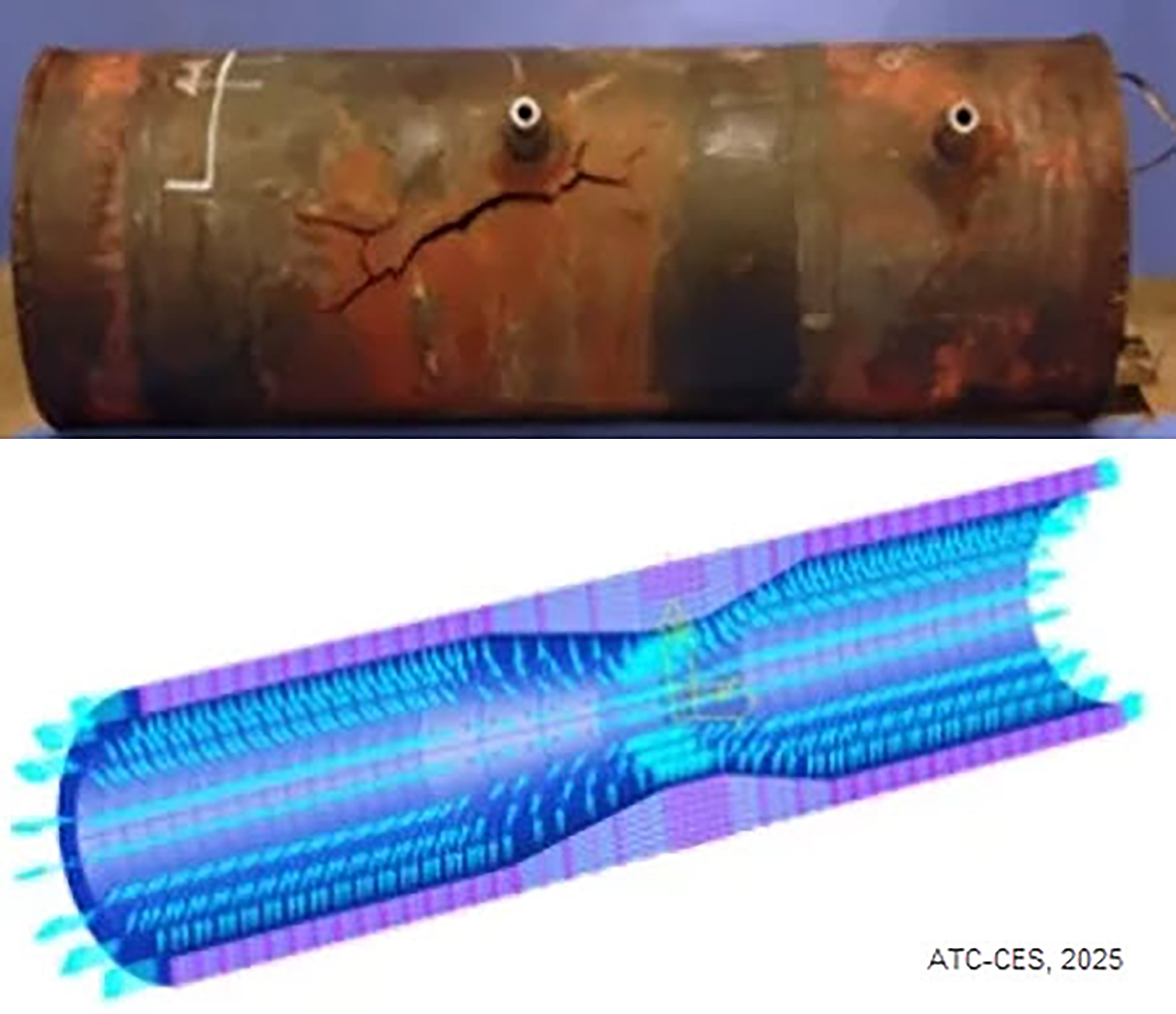
Transitioning from downtime to uptime:
The essential role of equipment owners in fast-tracking FFS analysis
Michael Crichton
Senior Engineer, Codes & Standards
Pressure Points Newsletter - March 2025
properties.trackTitle
properties.trackSubtitle
The timely completion of a Fitness for Service (FFS) analysis relies heavily on collaboration between equipment owners and engineering specialists and the sharing of accurate data and records. When equipment owners provide detailed operational histories, inspection reports, and design information from the beginning, engineers can quickly assess any flaws, degradation, or potential risks. On the other hand, insufficient data or delays in obtaining essential documents can slow down the process, resulting in unnecessary costs and extended downtime.
FFS is an engineering assessment of equipment for found damage, addressing the risk of failures while providing reliability estimates for operational challenges. It aims to minimize the potential for rupture and ensure reliability for continued operation. Crucial in industries such as oil and gas, chemical processing, and power generation, FFS evaluations determine a component’s remaining strength, identify risks for potential failure modes, and aid in evaluating possible repair or modification options. This process may extend the asset’s lifespan while aiming to minimize risk.
Key principles of FFS
| Level | Assessments |
|---|---|
| Level 1 (Screening) | These assessments require simple measurements and can often be done in hours. They quickly identify non-critical damage that doesn’t threaten equipment integrity. |
| Level 2 (Analytical) | These assessments offer a more detailed analysis with less conservative assumptions than Level 1, accurately reflecting equipment conditions using standardized calculations. |
| Level 3 (Advanced Analysis) | Represents the most sophisticated tier of FFS assessment, employing advanced numerical techniques to provide the most accurate evaluation of equipment condition. These assessments are typically used when Level 2 assessment results are marginal or when the damage mechanism is particularly complex. |
What the equipment owner can do to facilitate the engineering company’s analysis
For the engineering organization to perform a thorough and accurate FFS analysis, the equipment owner must provide critical information, documentation, and support. Listed here are some ways to streamline the process:
- Accurate Operational Data: Maintaining detailed and up-to-date operational records is essential. This documentation should include information about pressure cycles, temperature ranges, chemical exposures, and the results of previous inspections. A comprehensive operational history provides valuable insights into the component’s specific service and helps identify potential damage mechanisms. It is essential to agree on how data will be provided early, ensuring that file formats, sampling frequency, and data identifiers are clearly defined.
- Original Design Specifications: Whenever possible, the original design specifications, codes, and standards used during fabrication should be identified. These details enable the engineering team to compare “as-built” conditions to “as-inspected” conditions, identify any deviations, and understand the intended operating parameters of the design.
- Maintenance and Inspection Records: Providing records for maintenance, repairs, alterations, and historical inspections is essential for assessing the component’s history. Documenting previous non-destructive examinations (NDEs), thickness measurements, and any repairs, such as weld overlays or support/hanger assessments, is also beneficial.
- Accurate Dimensional Drawings: Accurate dimensional information is essential for modeling and evaluating equipment’s structural integrity. If original drawings are missing or outdated, the equipment owner may want to conduct a field survey using techniques such as laser scanning or manual measurements to obtain precise dimensions. Furthermore, any historical changes, including repairs and alterations, should be updated on the drawings as they occur.
- Material Data and Certifications: Verified material properties, including yield strength, tensile strength, impact toughness, chemical composition, and post-weld heat treatment, are essential for an accurate assessment. Equipment owners may opt for specialized testing if material test reports (MTRs) are unavailable. This can include hardness testing, optical emission spectrometry, or destructive sampling to utilize specific material properties for the assessment.
- Clear Communication of Goals: The equipment owner must communicate how they intend to operate the equipment in the future. This includes any service changes, plans for life extension, retirement date, or updated operating parameters so the analysis can incorporate these new requirements.
- Facilitation of On-Site Activities: Scheduling and coordinating on-site inspections with minimal disruption to operations can help expedite data collection. Additionally, ensuring that safety protocols and access permits are in place can prevent delays. It is also vital to consider abatement requirements and the specific material preparation needed for various inspection techniques.
Complications with older equipment using legacy materials and limited documentation
A significant challenge in conducting FFS analyses arises when dealing with older equipment, mainly if it was fabricated using materials since retired or for which proper documentation is missing. These difficulties can include:
- Unavailable or Incomplete Design Information: Many older assets were built decades ago under different codes or even before the existence of some standards. Original drawings, design calculations, and material reports may be lost, making it challenging to characterize specific material properties in evaluations. Engineering teams must devote additional effort to reconstructing these details through reverse engineering or applying conservative assumptions.
- Uncertain Material Properties: Legacy materials may exhibit different mechanical or chemical properties than modern alloys and lack standardized testing data. Even if material documentation exists, time-related degradation — like embrittlement, creep, or hydrogen damage — can alter the material’s effective properties. Engineers must conduct additional testing without reliable operational history or use conservative estimates.
- Material Degradation: Many older pieces of equipment have been subjected to service conditions that exceed their original design specifications. For instance, operating at higher pressures, elevated temperatures, or in the presence of more aggressive chemicals than originally anticipated can accelerate corrosion and crack growth, among other forms of damage. Engineers often depend on specialized or enhanced non-destructive testing (NDE) techniques to detect these flaws accurately. This situation complicates assessments and may result in recommendations for more frequent inspections or significant repairs.
- Complex or Obsolete Fabrication Techniques: Older equipment sometimes utilizes fabrication methods or welding techniques that do not align with current standards or for which reliable life prediction data might be insufficient. Assessing component integrity under these conditions can be challenging and may lead to modeling conservatism.
- Cost and Time Implications: Reconstructing missing information and conducting thorough testing on older equipment can be time-consuming and expensive. Equipment owners should assess the economic benefits of extending an asset’s lifespan against the potential risks and overhead costs associated with comprehensive FFS studies and future inspection costs. The equipment owner should consider the equipment’s capital cost, the lead time for its replacement, and the costs associated with FFS, including future reinspection, to determine whether repair, life extension, or replacement is the best option for the organization.
Contact us for a quote today

Flow nozzle fitness for service analysis performed by ATC

- Cracking was found in a flow nozzle after a chemical event caused by severe stress corrosion cracking
- The ATC-CES client intended to inspect the remaining nozzles during a short outage and needed to know the critical crack size
- ATC-CES used API 579, FEA, and STRAND7 to determine the depth of the crack where the nozzle was no longer stable
- The crack depth of .35” was determined to be the critical crack depth
- NDE personnel was able to inspect the flow nozzles in situ and advise if replacement was required
Contact us today
In conclusion
FFS reports provide essential data supporting equipment owners’ decisions regarding maintaining process equipment’s integrity and reliability. By supplying comprehensive operational data, design specifications, inspection records, and facilitating on-site measurements, equipment owners can empower engineering firms to conduct accurate FFS assessments efficiently.
However, challenges can arise when evaluating older assets, often due to incomplete documentation, outdated materials, and obsolete fabrication techniques. To tackle these complexities, thorough testing, conservative assumptions, and modern inspection methods may be required.
Ultimately, collaboration between equipment owners and engineering experts is crucial in making informed decisions regarding repairs, assessing remaining service life, and considering potential equipment upgrades. These efforts help ensure the continued operation of the equipment while minimizing risk for equipment failure.
About the author
Michael Crichton | Senior Engineer, Codes & Standards | michael_crichton@hsb.com
Michael Crichton joined the HSB Codes & Standards team in 2023. He holds a BS in welding engineering from the Ohio State University and is a Registered Professional Engineer. Before joining HSB, Michael spent 19 years in the utility industry as a quality assurance engineer and welding program owner. He has worked to maintain utility generation equipment through weld repairs and fitness for service. In his current role with Codes & Standards, Michael provides technical assistance for all non-nuclear ASME Boiler and Pressure Vessel Codes and the National Board Inspection Code (NBIC). His technical expertise is in condition assessment, life management, and welding. Michael currently serves as vice chair of the AWS D10 Committee on Piping & Tubing, is a member of AWS D10.10 Practices for Local PWHT, and chair of AWS D10.8 Welding of Chromium Moly Steel Piping and Tubing.



